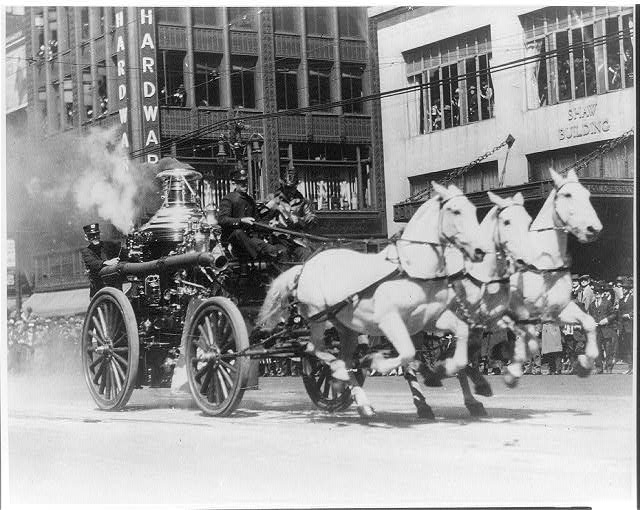
I doubt if there are many people still alive that remember seeing horses pull a steam-powered pumper to a fire. But for about 50 years, from the 1870’s until around 1920, it was a common occurrence in large cities.
The horses were very well trained. At some stations when the alarm would sound the horses’ stall doors would open and they would walk out and position themselves in the exact spot so the harness could be quickly applied.
Below is an excerpt from Dennis Smith’s History of Firefighting in America:
…The stalls were positioned behind or next to the rigs. In 1871, a quick hitch was developed. Two years later, Charles E. Berry, a Massachusetts firefighter, created a hanging harness with quick-locking hames. His invention was so popular he left the fire department and sold his patented Berry Hames and Collars nationwide.
Not every horse could serve as a fire horse. The animals needed to be strong, swift, agile, obedient and fearless. At the scene, they needed to stand patiently while embers and flames surrounded them. They needed to remain calm while the firefighters fought the blaze. This was the case in all weather conditions and in the midst of a multitude of distractions.
The fire departments carefully selected their horses. Veterinarians for the departments evaluated each animal. Both stallions and mares were eligible to serve.
In Detroit, weight requirements were issued for the animals. Those pulling hose wagons must weigh 1,100 pounds, to haul a steamer 1,400 pounds, and to cart a hook and ladder 1,700 pounds. Stations also tried to create matched teams of two and three horses when possible…
In the video below the animals appear to be very excited as they are being harnessed just before they launch out of the station into a full gallop.
Fire horses became famous and much loved in the cities. In the next video some of the bystanders seem to be as excited as the horses.

In some cities including Los Angeles and Boston an Attic Ladder is known as a “Baby Bangor”
Steam Engineer, David?
Glad to see Dallas can still perform that evolution.
Here is the San Francisco Fire Department performing a Church Raise with a Bangor Ladder (see linked glossary above)
https://www.youtube.com/watch?v=E-BqSs5FA-o
Boiler Operator?
Speaking of San Francisco, they are the last traditional fire department on the West coast. They still wear leather helmets and use wooden ladders. Their ladder shop also builds all of the new ladders:
https://www.youtube.com/watch?v=Jbu1HVFELog
They can still make a church raise. A skill lost by most fire departments.
Cannot find Church Raise in my Glossary of Wildland Fire Terminology.
http://www.fireserviceinfo.com/glossary.html#C
https://www.youtube.com/watch?v=qwPUmYlYACM
lol….maybe they could train for the church raise to do with some of those 350+ pines in the Sierra Nevada’s?
our little dept stopped doing them in the early 80s,used to scare the bejesus out of me.
that is if this means where the ladder is placed vertically,with just 4 lines down and two men on the bottom of the latter…i did not like that,but i did it.
back in 1991,we (Auburn city Fire,Auburn Ca) hosted the California state championship Muster competition.We had three operating steamers,Reno,Woodland and one from San Francisco i believe.During the finals on sunday,all three were fired and at one point pumping at full capacity.they were literally dancing around on the pavement. One of our fire capts,Bill Taylor,was a lic’d steam operator ( there’s an official word for it,but i don’t know it offhand)and he was overseeing the op’s.i’ll tell you,it was a sight to be experienced,not just seen.I don’t recall which ones,but at least one was coal fired,the others wood,,or the other way round.
My mother lived across from the fire station in detroit 1910-1925 – and told us stories about the horses there and their crew – favorites of all the neighborhood kids.
The FDNY had well over 200 Steamers. Only one or two are in existence. The Billings MT Fire Department had a Steamer. The Billings Fire Deartment’s first motorized apparatus was a 1911 Chemical Engine which was followed by a 1916 Pirsch hand cranked Aerial ladder which remained in the department until the mid-60’s.
I highly recommend all of Dennis Smith’s books, both fiction and nonfiction. “Report From Engine Company 82” is a classic and is still in print 46 years after it was first published. The book is required reading for anyone aspiring to a career in fire. The following is link to a British documentary filmed a year after “Report From Engine Company 82” was published.
https://www.youtube.com/watch?v=ygF3NJvy3bY
I would agree on the “Report from Engine Company 82” as both a classic and must read for aspiring firefighters. He knows his stuff as a front line, nonsense firefighter and a damn good storyteller and writer.